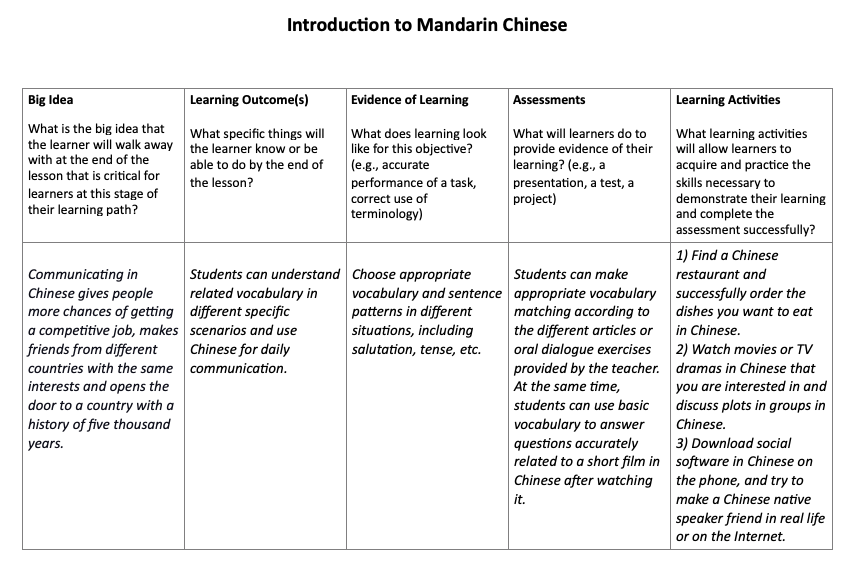In the study of instructional design this week, I realized the importance of constructive alignment and backward design, especially backward design is a thinking concept that can be used in course design or life simultaneously. According to my understanding, the thinking mode of backward design will focus more on students in the teacher’s curriculum design—-aiming at students’ mastery of knowledge, rather than taking the teacher’s completion of teaching objectives as the focus of curriculum design, that way it can improve the efficiency of learning for students. In the template below, I refer to Merrill’s principles to make a course design for Chinese language learning (2002).
My Mandarin Chinese Course Plan Template:

How do I feel about applying Merrill’s principles:
I must admit that the backward design thinking method has subverted my old way of thinking. Now I understand that we cannot only pursue teaching goals but also consider whether students can thoroughly understand relevant knowledge when they learn new knowledge.
After I made the course plan that referred to Merrill’s principles, for instance:
- Learners are engaged in solving real-world problems
- New knowledge is applied by the learner
- New knowledge is integrated into the learner’s world
I profoundly realized the importance of enabling students to apply their knowledge to real life rather than blindly pursuing tedious written answers. I like this teaching philosophy because it increases student engagement and interest.
For example, students can order food in Chinese in a Chinese restaurant, which is also an achievement that allows students to feel interactive and apply relevant knowledge in real life.

After students use different languages to communicate with native speakers successfully, students can get a great sense of achievement. Overall, students will have more intentions for future learning through this state of learning.
References:
Merrill, M. D. (2002). First Principles of Instruction. ETR&D, 50, 3. pp. 43-59.
YouTube. (2019, April 1). Backwards design: A great way to move forward! YouTube. Retrieved October 14, 2022, from https://www.youtube.com/watch?v=mLKHaNo98Ts





lingjiang
2022-10-15 — 11:53 pm
Hi, Jiahao
I agree with the idea of enabling students to apply their knowledge to real life because I used to learn a lot of knowledge, and I didn’t know how to use it to solve problems in real life. It makes me feel like I waste a lot of time learning helpless knowledge. This feeling stops me from studying somehow. I am wondering that for learning a new language, is there any other way to practice vocabulary about daily life? Because ordering food in restaurant can only help on vocabulary about food. Thanks for sharing this method.
darby
2022-10-20 — 2:51 pm
Hello !
Great post! Your lesson plan is very thorough and includes many relevant real world experiences such as ordering food, watching films, and using social software. I like how you have included these real world experiences not only in the learning assessment and outcomes but in the learning activities as well. I wonder if this would also increase one’s motivation to learn? as the learner is being exposed to the new information, they are seeing all the relevant ways it could be useful to them while they are learning and getting direct feedback from these experiences. Very interesting to think about!
Darby